Attached files
| file | filename |
|---|---|
| 8-K - 8-K - FEDERAL HOME LOAN MORTGAGE CORP | f71246e8vk.htm |
| EX-99.1 - EXHIBIT 99.1 - FEDERAL HOME LOAN MORTGAGE CORP | f71246exv99w1.htm |
| EX-99.2 - EXHIBIT 99.2 - FEDERAL HOME LOAN MORTGAGE CORP | f71246exv99w2.htm |
Exhibit 99.3
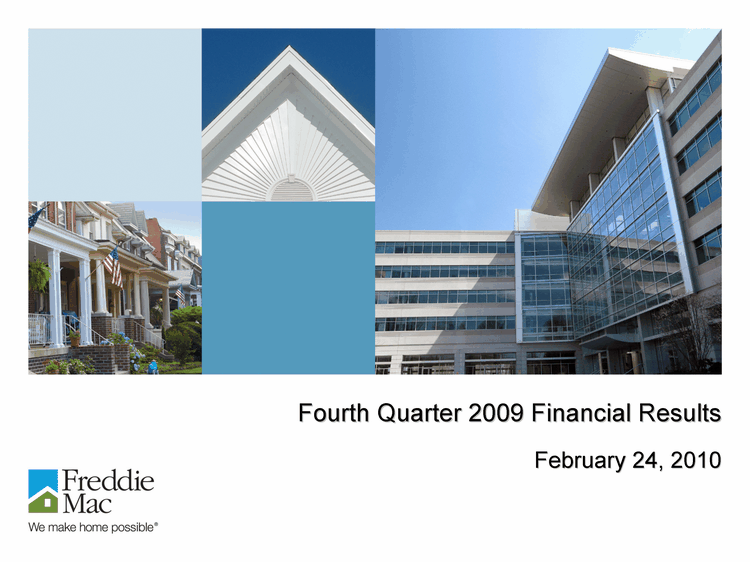
| Fourth Quarter 2009 Financial Results February 24, 2010 |

| Table of contents |

| Quarterly GAAP financial results Line 1: Net interest income continues to benefit from lower funding costs due to lower interest rates on the company's short- and long-term debt issuances. Line 3: Net mark-to-market gains were driven by increased long-term interest rates and tighter spreads on the company's derivative portfolio, guarantee asset and trading securities. See slide 8. Line 4: Net impairment of AFS securities declined in 4Q 2009 as the rate of deterioration of mortgage collateral continued to moderate. Line 6: In 4Q 2009 the company wrote down the carrying value of its low-income housing tax credit partnership investments to zero. Line 10: Credit-related expenses remained elevated due to continued credit deterioration and challenging economic conditions. Line 11: Losses on loans purchased increased in 4Q 2009 due to an increase in the volume of loans purchased out of PC pools driven by higher loan modification settlements. 1 AFS security impairments are primarily credit-related as a result of the adoption of new accounting guidance related to the recognition of other-than-temporary impairments on April 1, 2009. 4Q 2008 amount includes both credit- and non-credit-related security impairments. 2 Freddie Mac revised its previously reported results for the first three quarters of 2009. For more information see the company's Annual Report on Form 10-K for the year ended December 31, 2009. Note: Certain amounts in prior periods have been reclassified to conform to the current presentation. |
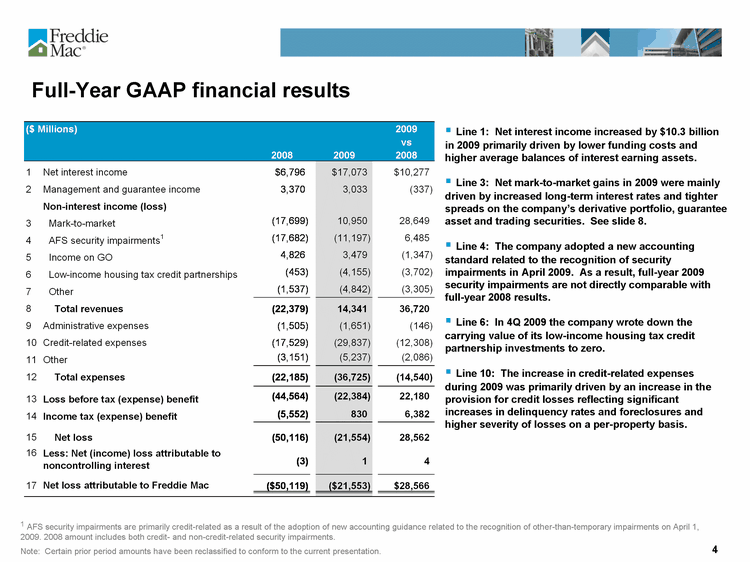
| Full-Year GAAP financial results Line 1: Net interest income increased by $10.3 billion in 2009 primarily driven by lower funding costs and higher average balances of interest earning assets. Line 3: Net mark-to-market gains in 2009 were mainly driven by increased long-term interest rates and tighter spreads on the company's derivative portfolio, guarantee asset and trading securities. See slide 8. Line 4: The company adopted a new accounting standard related to the recognition of security impairments in April 2009. As a result, full-year 2009 security impairments are not directly comparable with full-year 2008 results. Line 6: In 4Q 2009 the company wrote down the carrying value of its low-income housing tax credit partnership investments to zero. Line 10: The increase in credit-related expenses during 2009 was primarily driven by an increase in the provision for credit losses reflecting significant increases in delinquency rates and foreclosures and higher severity of losses on a per-property basis. 1 AFS security impairments are primarily credit-related as a result of the adoption of new accounting guidance related to the recognition of other-than-temporary impairments on April 1, 2009. 2008 amount includes both credit- and non-credit-related security impairments. Note: Certain prior period amounts have been reclassified to conform to the current presentation. |

| Total equity and Purchase Agreement with Treasury 1 Reflects the adoption of new accounting guidance on January 1, 2009, which resulted in the classification of noncontrolling interests as part of total equity (deficit). 4Q 2008 data has been reclassified to conform to the current presentation. 2 As a result of the company's adoption of new accounting guidance related to other-than-temporary impairments on April 1, 2009, the company recognized a cumulative-effect adjustment of $15.0 billion to its opening balance of retained earnings (accumulated deficit), with a corresponding adjustment of $(9.9) billion, net of tax, to AOCI. The difference of $5.1 billion represents an increase in total equity primarily resulting from the release of the valuation allowance previously recorded against the company's deferred tax asset that was no longer required upon adoption. 3 Freddie Mac revised its previously reported results for the first three quarters of 2009. For more information see the company's Annual Report on Form 10-K for the year ended December 31, 2009. 4 4Q 2009 Dividends and other, net includes a cash dividend payment of $1.3 billion to the U.S. Department of the Treasury (Treasury) on December 31, 2009 for the period from October 1, 2009 through December 31, 2009 on the senior preferred stock issued to Treasury. 5 The aggregate liquidation preference of the senior preferred stock of $51.7 billion at December 31, 2009 includes the initial $1 billion of senior preferred stock issued to Treasury as consideration for its funding commitment. Based on the $51.7 billion balance, Treasury is entitled to annual cash dividends of approximately $5.2 billion. |
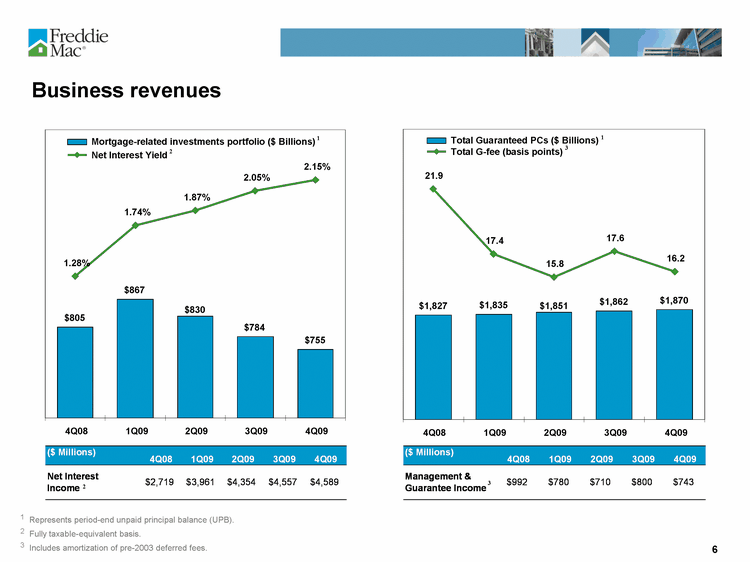
| $805 $867 $784 $755 $830 1.28% 1.74% 1.87% 2.05% 2.15% $600 $700 $800 $900 $1,000 $1,100 $1,200 4Q08 1Q09 2Q09 3Q09 4Q09 0.00% 0.40% 0.80% 1.20% 1.60% 2.00% 2.40% Mortgage-related investments portfolio ($ Billions) Net Interest Yield $1,827 $1,835 $1,862 $1,870 $1,851 21.9 17.4 15.8 17.6 16.2 $1,000 $1,500 $2,000 $2,500 $3,000 4Q08 1Q09 2Q09 3Q09 4Q09 6.0 8.0 10.0 12.0 14.0 16.0 18.0 20.0 22.0 24.0 26.0 Total Guaranteed PCs ($ Billions) Total G-fee (basis points) Business revenues 1 Represents period-end unpaid principal balance (UPB). 2 Fully taxable-equivalent basis. 3 Includes amortization of pre-2003 deferred fees. 2 2 1 1 3 3 |

| Reserve for loan losses $2,822 $3,872 $5,813 $10,220 $22,802 $545 $942 $863 $1,014 $1,907 $2,252 $2,421 $8,915 $5,665 $7,973 $15,618 $25,787 $33,857 $30,564 $320 $111 $6,977 $787 $1,240 $2,537 $5,702 $6,953 0.53% 1.30% 1.16% 0.81% 0.30% 0.21% 0.16% 1.69% 1.53% $0 $5,000 $10,000 $15,000 $20,000 $25,000 $30,000 $35,000 4Q 2007 1Q 2008 2Q 2008 3Q 2008 4Q 2008 1Q 2009 2Q 2009 3Q 2009 4Q 2009 Period End Balance ($ Millions) 0.00% 0.20% 0.40% 0.60% 0.80% 1.00% 1.20% 1.40% 1.60% 1.80% Reserve as a % of Total Mortgage Portfolio Reserve for Loan Losses Net Charge-offs Provision Reserve as % of Total Mortgage Portfolio 1 Freddie Mac revised its previously reported results for the first three quarters of 2009. For more information see the company's Annual Report on Form 10-K for the year ended December 31, 2009. 1 1 1 |
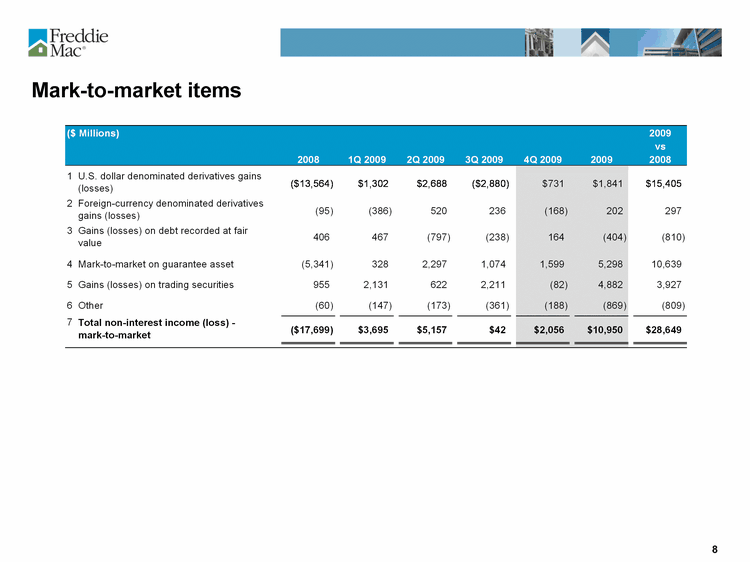
| Mark-to-market items |

| Adoption of SFAS 166 and 167 Approximate impact of change in accounting Note: For more information on the impact of the adoption of SFAS 166 and 167 see the company's Annual Report on Form 10-K for the year ended December 31, 2009. |

| Supporting the housing market in 2009 1 Estimate based on internal Freddie Mac single-family funding volumes for 2009 divided by the gross mortgage origination amount as reported by Inside Mortgage Finance. 2 Freddie Mac's total refinancing and borrower savings amounts are for the full-year 2009, as of December 31. Annual savings represents the estimated reduction of interest paid by the borrower during the first year of refinance (note rate reduction multiplied by new mortgage balance). 3 Based on information reported by the Making Home Affordable (MHA) program administrator as of January 19, 2010. Provided much needed liquidity and helped keep mortgage rates low Purchased or guaranteed approximately 1 out of every 4 home loans originated during the year1 Purchased or guaranteed over $500 billion in mortgages and mortgage-related securities Lowered mortgage payments Refinanced approximately $379 billion in home loans creating an estimated $4.5 billion in annual interest savings for approximately 1.8 million families2 Continued focus on foreclosure prevention Implemented more than 140,000 trial and permanent loan modifications under the Administration's Home Affordable Modification Program (HAMP)3 |

| Freddie Mac helped to refinance approximately 1.8 million borrowers in 2009 Estimated total annual borrower savings of $4.51 billion Estimated annual savings of over $2,5001 per refinanced borrower Relief Refinances under the MHA program continue to increase as a percentage of overall refinances Freddie Mac refinance activity Cumulative refinance activity through December 2009 Relief Refi (CLTV 80% - 125%) Non-Relief Refi Relief Refi (CLTV < 80%) Cumulative Refinance Totals 2 1 Annual savings represents the estimated reduction of interest paid by the borrower during the first year of refinance (note rate reduction multiplied by new mortgage balance). Calculated based on Freddie Mac Relief Refinance MortgagesSM and other refinance mortgages. 2 Relief Refinance volumes with CLTV >80% are Home Affordable Refinance program (HARP) loans under the MHA program. |
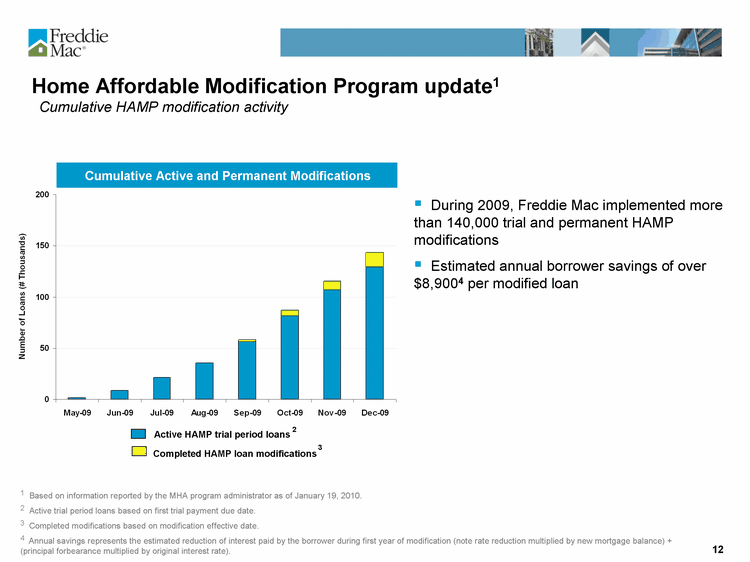
| Active HAMP trial period loans Completed HAMP loan modifications During 2009, Freddie Mac implemented more than 140,000 trial and permanent HAMP modifications Estimated annual borrower savings of over $8,9004 per modified loan 1 Based on information reported by the MHA program administrator as of January 19, 2010. 2 Active trial period loans based on first trial payment due date. 3 Completed modifications based on modification effective date. 4 Annual savings represents the estimated reduction of interest paid by the borrower during first year of modification (note rate reduction multiplied by new mortgage balance) + (principal forbearance multiplied by original interest rate). Home Affordable Modification Program update1 Cumulative HAMP modification activity 2 3 Cumulative Active and Permanent Modifications |
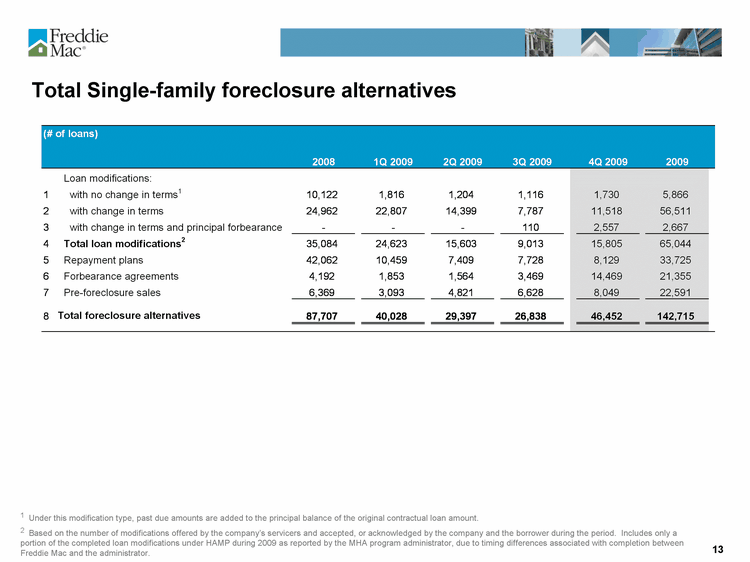
| Total Single-family foreclosure alternatives 1 Under this modification type, past due amounts are added to the principal balance of the original contractual loan amount. 2 Based on the number of modifications offered by the company's servicers and accepted, or acknowledged by the company and the borrower during the period. Includes only a portion of the completed loan modifications under HAMP during 2009 as reported by the MHA program administrator, due to timing differences associated with completion between Freddie Mac and the administrator. |

| Credit Supplement |
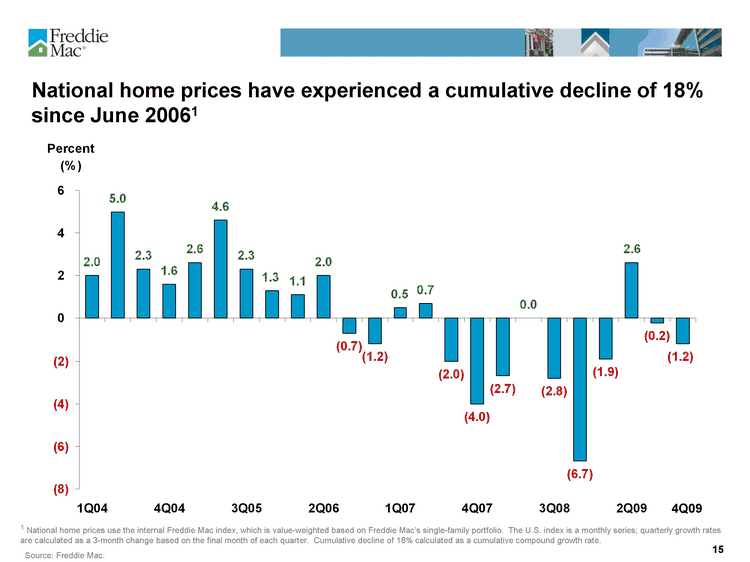
| National home prices have experienced a cumulative decline of 18% since June 20061 1 National home prices use the internal Freddie Mac index, which is value-weighted based on Freddie Mac's single-family portfolio. The U.S. index is a monthly series; quarterly growth rates are calculated as a 3-month change based on the final month of each quarter. Cumulative decline of 18% calculated as a cumulative compound growth rate. Source: Freddie Mac. 4Q09 |

| 30 States had home price declines from December 2008 to December 20091 1 National home prices use the internal Freddie Mac index, which is value-weighted based on Freddie Mac's single-family portfolio. The state index is a monthly series; annual growth rates are calculated as a 12-month change. Source: Freddie Mac. United States -0.8% |
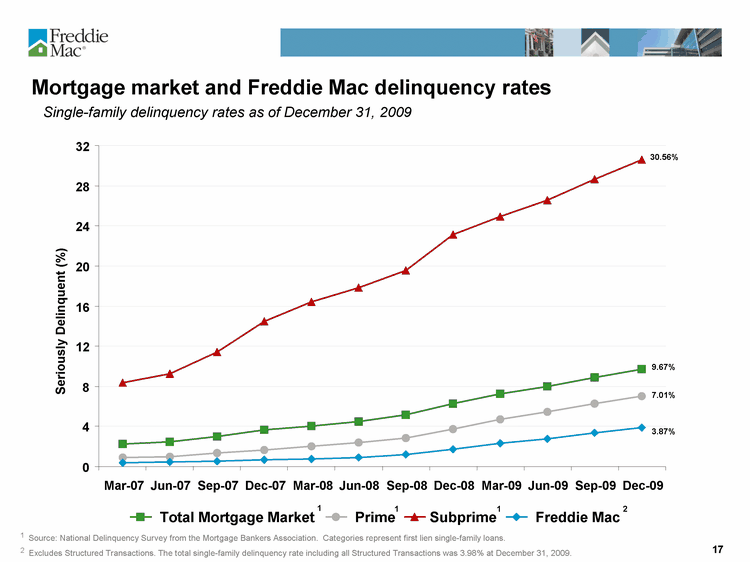
| Mortgage market and Freddie Mac delinquency rates Single-family delinquency rates as of December 31, 2009 1 Source: National Delinquency Survey from the Mortgage Bankers Association. Categories represent first lien single-family loans. 2 Excludes Structured Transactions. The total single-family delinquency rate including all Structured Transactions was 3.98% at December 31, 2009. 0 4 8 12 16 20 24 28 32 Mar-07 Jun-07 Sep-07 Dec-07 Mar-08 Jun-08 Sep-08 Dec-08 Mar-09 Jun-09 Sep-09 Dec-09 Seriously Delinquent (%) Total Mortgage Market Prime Subprime Freddie Mac 1 2 1 1 3.87% 7.01% 9.67% 30.56% |
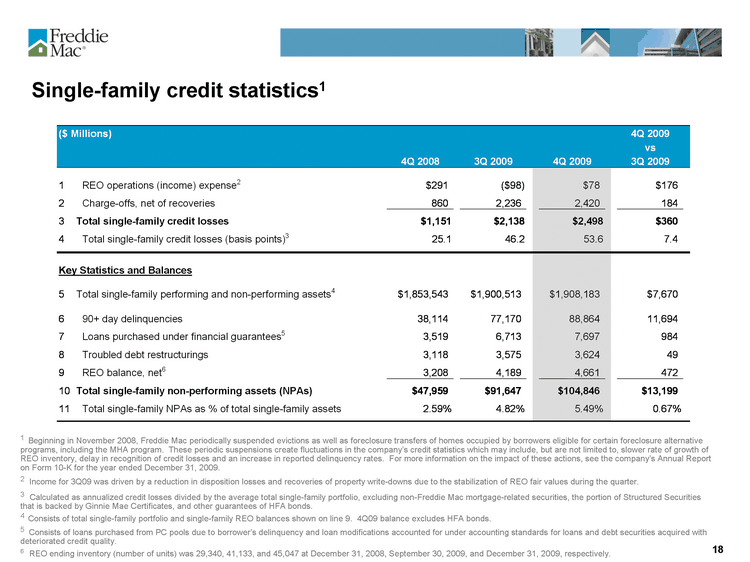
| Single-family credit statistics1 1 Beginning in November 2008, Freddie Mac periodically suspended evictions as well as foreclosure transfers of homes occupied by borrowers eligible for certain foreclosure alternative programs, including the MHA program. These periodic suspensions create fluctuations in the company's credit statistics which may include, but are not limited to, slower rate of growth of REO inventory, delay in recognition of credit losses and an increase in reported delinquency rates. For more information on the impact of these actions, see the company's Annual Report on Form 10-K for the year ended December 31, 2009. 2 Income for 3Q09 was driven by a reduction in disposition losses and recoveries of property write-downs due to the stabilization of REO fair values during the quarter. 3 Calculated as annualized credit losses divided by the average total single-family portfolio, excluding non-Freddie Mac mortgage-related securities, the portion of Structured Securities that is backed by Ginnie Mae Certificates, and other guarantees of HFA bonds. 4 Consists of total single-family portfolio and single-family REO balances shown on line 9. 4Q09 balance excludes HFA bonds. 5 Consists of loans purchased from PC pools due to borrower's delinquency and loan modifications accounted for under accounting standards for loans and debt securities acquired with deteriorated credit quality. 6 REO ending inventory (number of units) was 29,340, 41,133, and 45,047 at December 31, 2008, September 30, 2009, and December 31, 2009, respectively. |

| Single-family credit losses by book year1 and state 1 Book year indicates year of loan origination. 2 Excludes Structured Securities backed by Ginnie Mae Certificates and other guarantees of HFA bonds. 3 Credit losses consist of the aggregate amount of charge-offs, net of recoveries, and the amount of REO operations expense in each of the respective periods. 4 Based on the number of mortgages 90 days or more delinquent or in foreclosure. Percentage based on loan counts. Includes all Structured Transactions where loan characteristics data exists. The total delinquency rate excluding all Structured Transactions was 3.87% at December 31, 2009. |

| Single-family 4Q 2009 credit losses & REO counts by region and state 1 Excludes Structured Securities backed by Ginnie Mae Certificates and other guarantees of HFA bonds. 2 Based on the number of mortgages 90 days or more delinquent or in foreclosure. UPB amounts exclude certain Structured Transactions. 3 Based on the UPB of loans at the time of REO acquisition. 4 Credit losses consist of the aggregate amount of charge-offs, net of recoveries, and the amount of REO operations expense. |

| Single-family portfolio characteristics1 5 4 3 1 Portfolio characteristics are based on the unpaid principal balance of the single-family mortgage portfolio excluding Structured Securities backed by Ginnie Mae Certificates, other guarantees of HFA bonds, and certain Structured Transactions for which the loan characteristics data is not available. 2 Loans purchased through bulk transactions and identified as Alt-A by the seller or if the loans had reduced documentation requirements, as well as a combination of certain credit characteristics and expected performance characteristics at acquisition which, when compared to full documentation loans in our portfolio, indicate that the loan should be classified as Alt-A. There are circumstances where loans with reduced documentation are not classified as Alt-A because the loans were part of a refinancing of a pre-existing full documentation loan that we already guaranteed or the loans fall within various programs which we believe support not classifying the loans as Alt-A. 3 Total Portfolio UPB of $1,904 billion excludes HFA bonds. 4 Although many borrowers likely have third-party 2nd liens, this represents borrowers' secondary mortgage loan financing guaranteed by Freddie Mac. 5 Includes Structured Transactions. The total delinquency rate excluding all Structured Transactions was 3.87% at December 31, 2009. Note: Categories other than total portfolio are based on internal management reports as of December 31, 2009 or most current period prior to December 31, 2009. Individual categories are not exclusive, and are not additive across columns. |
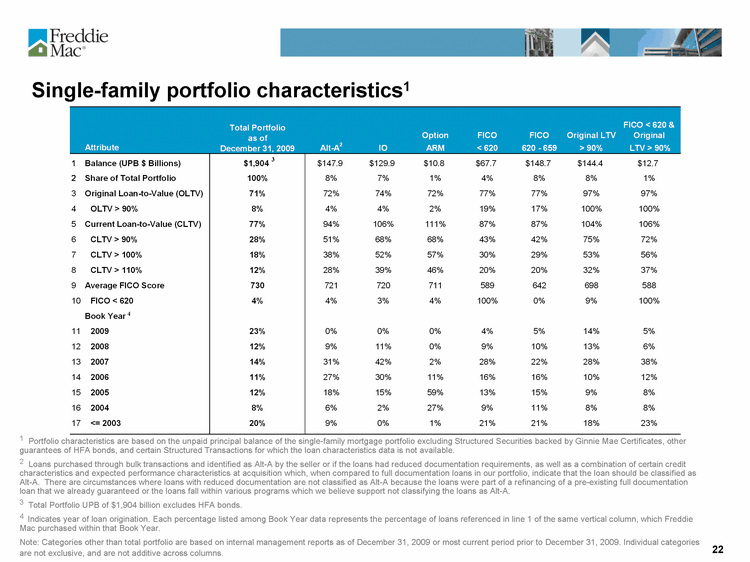
| Single-family portfolio characteristics1 4 3 1 Portfolio characteristics are based on the unpaid principal balance of the single-family mortgage portfolio excluding Structured Securities backed by Ginnie Mae Certificates, other guarantees of HFA bonds, and certain Structured Transactions for which the loan characteristics data is not available. 2 Loans purchased through bulk transactions and identified as Alt-A by the seller or if the loans had reduced documentation requirements, as well as a combination of certain credit characteristics and expected performance characteristics at acquisition which, when compared to full documentation loans in our portfolio, indicate that the loan should be classified as Alt-A. There are circumstances where loans with reduced documentation are not classified as Alt-A because the loans were part of a refinancing of a pre-existing full documentation loan that we already guaranteed or the loans fall within various programs which we believe support not classifying the loans as Alt-A. 3 Total Portfolio UPB of $1,904 billion excludes HFA bonds. 4 Indicates year of loan origination. Each percentage listed among Book Year data represents the percentage of loans referenced in line 1 of the same vertical column, which Freddie Mac purchased within that Book Year. Note: Categories other than total portfolio are based on internal management reports as of December 31, 2009 or most current period prior to December 31, 2009. Individual categories are not exclusive, and are not additive across columns. |
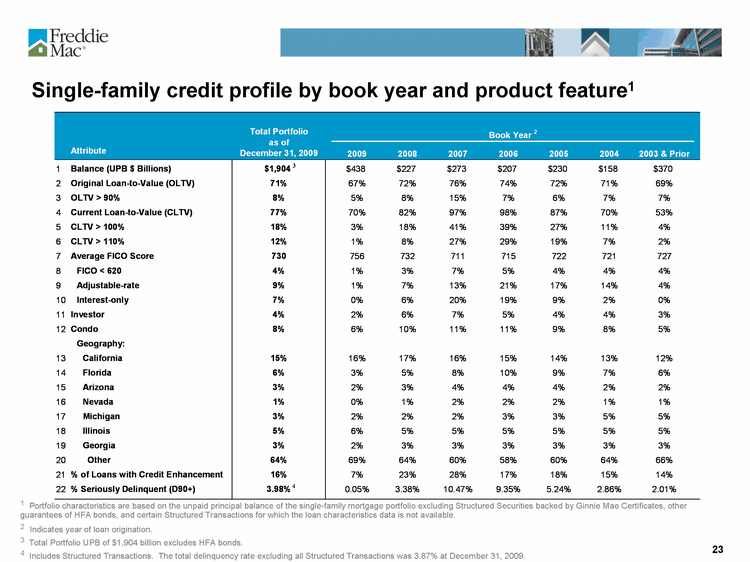
| Single-family credit profile by book year and product feature1 4 3 1 Portfolio characteristics are based on the unpaid principal balance of the single-family mortgage portfolio excluding Structured Securities backed by Ginnie Mae Certificates, other guarantees of HFA bonds, and certain Structured Transactions for which the loan characteristics data is not available. 2 Indicates year of loan origination. 3 Total Portfolio UPB of $1,904 billion excludes HFA bonds. 4 Includes Structured Transactions. The total delinquency rate excluding all Structured Transactions was 3.87% at December 31, 2009. |
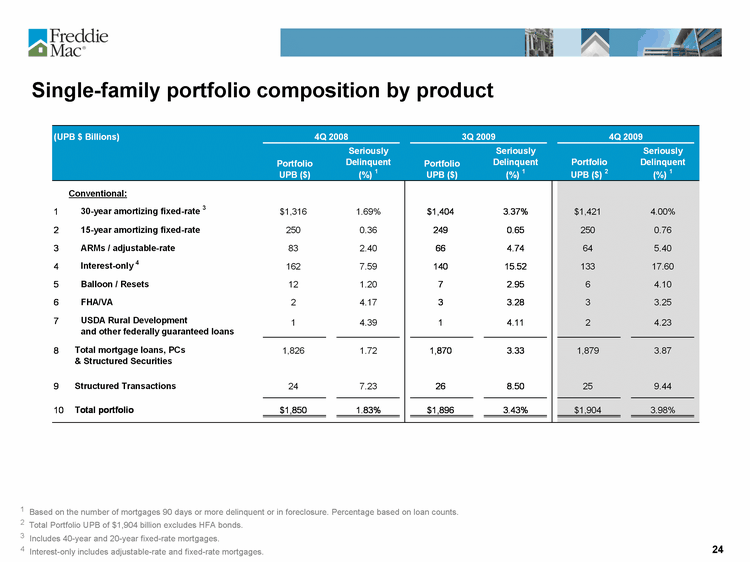
| Single-family portfolio composition by product 1 Based on the number of mortgages 90 days or more delinquent or in foreclosure. Percentage based on loan counts. 2 Total Portfolio UPB of $1,904 billion excludes HFA bonds. 3 Includes 40-year and 20-year fixed-rate mortgages. 4 Interest-only includes adjustable-rate and fixed-rate mortgages. |
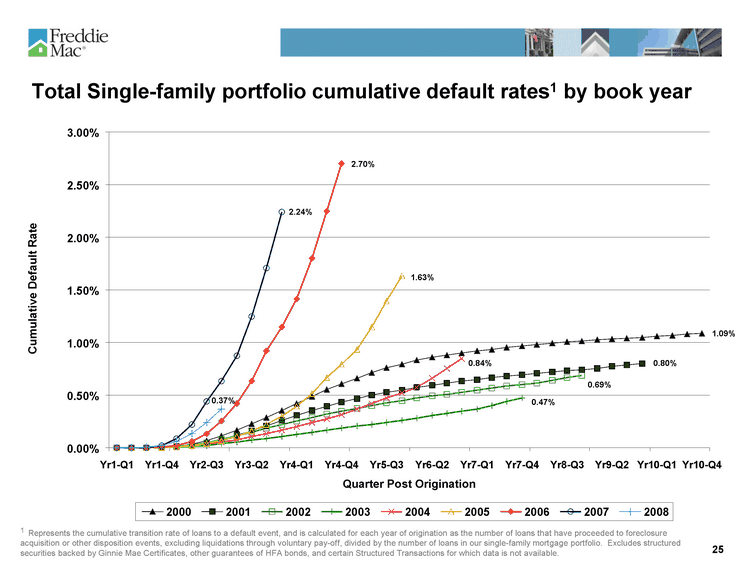
| 0.00% 0.50% 1.00% 1.50% 2.00% 2.50% 3.00% Yr1-Q1 Yr1-Q4 Yr2-Q3 Yr3-Q2 Yr4-Q1 Yr4-Q4 Yr5-Q3 Yr6-Q2 Yr7-Q1 Yr7-Q4 Yr8-Q3 Yr9-Q2 Yr10-Q1 Yr10-Q4 Quarter Post Origination Cumulative Default Rate 2000 2001 2002 2003 2004 2005 2006 2007 2008 Total Single-family portfolio cumulative default rates1 by book year 0.37% 2.24% 2.70% 1.63% 0.84% 0.47% 0.69% 0.80% 1.09% 1 Represents the cumulative transition rate of loans to a default event, and is calculated for each year of origination as the number of loans that have proceeded to foreclosure acquisition or other disposition events, excluding liquidations through voluntary pay-off, divided by the number of loans in our single-family mortgage portfolio. Excludes structured securities backed by Ginnie Mae Certificates, other guarantees of HFA bonds, and certain Structured Transactions for which data is not available. |
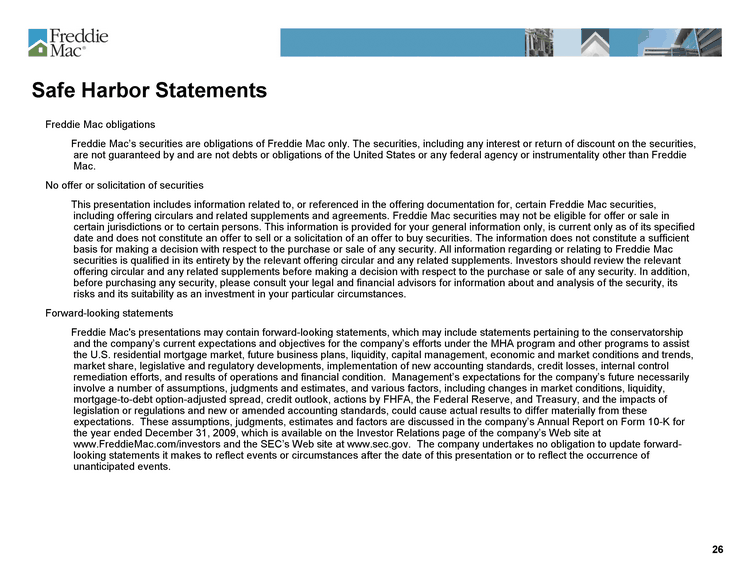
| Safe Harbor Statements Freddie Mac obligations Freddie Mac's securities are obligations of Freddie Mac only. The securities, including any interest or return of discount on the securities, are not guaranteed by and are not debts or obligations of the United States or any federal agency or instrumentality other than Freddie Mac. No offer or solicitation of securities This presentation includes information related to, or referenced in the offering documentation for, certain Freddie Mac securities, including offering circulars and related supplements and agreements. Freddie Mac securities may not be eligible for offer or sale in certain jurisdictions or to certain persons. This information is provided for your general information only, is current only as of its specified date and does not constitute an offer to sell or a solicitation of an offer to buy securities. The information does not constitute a sufficient basis for making a decision with respect to the purchase or sale of any security. All information regarding or relating to Freddie Mac securities is qualified in its entirety by the relevant offering circular and any related supplements. Investors should review the relevant offering circular and any related supplements before making a decision with respect to the purchase or sale of any security. In addition, before purchasing any security, please consult your legal and financial advisors for information about and analysis of the security, its risks and its suitability as an investment in your particular circumstances. Forward-looking statements Freddie Mac's presentations may contain forward-looking statements, which may include statements pertaining to the conservatorship and the company's current expectations and objectives for the company's efforts under the MHA program and other programs to assist the U.S. residential mortgage market, future business plans, liquidity, capital management, economic and market conditions and trends, market share, legislative and regulatory developments, implementation of new accounting standards, credit losses, internal control remediation efforts, and results of operations and financial condition. Management's expectations for the company's future necessarily involve a number of assumptions, judgments and estimates, and various factors, including changes in market conditions, liquidity, mortgage-to-debt option-adjusted spread, credit outlook, actions by FHFA, the Federal Reserve, and Treasury, and the impacts of legislation or regulations and new or amended accounting standards, could cause actual results to differ materially from these expectations. These assumptions, judgments, estimates and factors are discussed in the company's Annual Report on Form 10-K for the year ended December 31, 2009, which is available on the Investor Relations page of the company's Web site at www.FreddieMac.com/investors and the SEC's Web site at www.sec.gov. The company undertakes no obligation to update forward- looking statements it makes to reflect events or circumstances after the date of this presentation or to reflect the occurrence of unanticipated events. |
